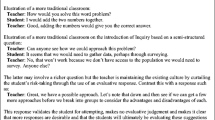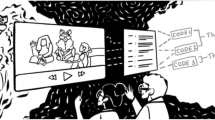Abstract
During 46 lessons in Euclidean geometry, sixth-grade students (ages 11, 12) were initiated in the mathematical practice of inquiry. Teachers supported inquiry by soliciting student questions and orienting students to related mathematical habits-of-mind such as generalizing, developing relations, and seeking invariants in light of change, to sustain investigations of their questions. When earlier and later phases of instruction were compared, student questions reflected an increasing disposition to seek generalization and to explore mathematical relations, forms of thinking valued by the discipline. Less prevalent were questions directed toward search for invariants in light of change. But when they were posed, questions about change tended to be oriented toward generalizing and establishing relations among mathematical objects and properties. As instruction proceeded, students developed an aesthetic that emphasized the value of questions oriented toward the collective pursuit of knowledge. Post-instructional interviews revealed that students experienced the forms of inquiry and investigation cultivated in the classroom as self-expressive.




Similar content being viewed by others
References
Abelson, H. & diSessa, A. A. (1980). Turtle geometry: The computer as a medium for exploring mathematics. The Massachusetts Institute of Technology.
Azevedo, F. S. (2006). Personal excursions: Investigating the dynamics of student engagement. International Journal of Computers for Mathematical Learning, 11, 57–98.
Ball, D. L. (1993). With an eye on the mathematical horizon: Dilemmas of teaching elementary school mathematics. The Elementary School Journal, 4, 373–397.
Barron, B. (2006). Interest and self-sustained learning as catalysts of development: A learning ecology perspective. Human Development, 49, 193–224.
Boaler, J. (2002). Experiencing school mathematics: Traditional and reform approaches to teaching and their impact on student learning (Revised and Expanded Edition ed.). Mahwah, NJ: Lawrence Erlbaum Association.
Borasi, R. (1992). Learning mathematics through inquiry. New Hampshire: Heinemann Educational Books, Inc.
Chapin, S. H., O’Connor, C., & Anderson, N. C. (2003). Classroom discussions. Using MATH TALK to help students learn. Sausalito, CA: Math Solutions.
de Villiers, M. (1998). An alternative approach to proof in dynamic geometry. In R. Lehrer & D. Chazan (Eds.), Designing learning environments for developing understanding of geometry and space (pp. 369–393). Mahwah, NJ: Erlbaum.
diSessa, A. A. (2004). Metarepresentation: Native competence and targets for instruction. Cognition & Instruction, 22(3), 293–331.
Driscoll, M., DiMatteo, R. W., Nikula, J. E., & Egan, M. (2007). Fostering geometric thinking: A guide for teachers grades 5–10. Portsmouth, NH: Heinemann.
Ellis, A. B. (2011). Generalizing-promoting actions: How classroom collaborations can support students’ mathematical generalizations. Journal for Research in Mathematics Education., 42(4), 308–345.
Goldenberg, E. P., & Cuoco, A. A. (1998). What is dynamic geometry? In R. Lehrer & D. Chazan (Eds.), Designing learning environments for developing understanding of geometry and space (pp. 351–367). Mahwah, NJ: Erlbaum.
Goldenberg, E. P., Cuoco, A. A., & Mark, J. (1998). A role for geometry in general education. In R. Lehrer & D. Chazan (Eds.), Designing learning environments for developing understanding of geometry and space (pp. 3–44). Mahwah, NJ: Erlbaum.
Gresalfi, M. S. (2009). Taking up opportunities to learn: Constructing dispositions in mathematics classrooms. The Journal of the Learning Sciences, 18(3), 327–369.
Hadas, N., Hershkowitz, R., & Schwarz, B. B. (2000). The role of contradiction and uncertainty in promoting the need to prove in dynamic geometry environments. Educational Studies in Mathematics, 44, 127–150.
Harel, G. (2008). What is mathematics? A pedagogical answer to a philosophical question. In B. Gold & R. Simons (Eds.), Current issues in the philosophy of mathematics from the perspective of mathematicians. Washington, DC: Mathematical American Association.
Henderson, D. W., & Taimina, D. (2005). Experiencing geometry: Euclidean and non-euclidean with history. Upper Saddle River, NJ: Pearson Prentice Hall.
Hidi, S., & Renninger, K. A. (2006). The four-phase model of interest development. Educational Psychologist, 41(2), 111–127.
Hufferd-Ackles, K., Fuson, K. C., & Sherin, M. G. (2004). Describing levels and components of a math-talk learning community. Journal for Research in Mathematics Education, 35, 81–116.
Hwang, S., & Roth, W.-M. (2011). Scientific and mathematical bodies. Rotterdam: Sense Publishers.
Knorr Cetina, K. (1999). Epistemic cultures: How the sciences make knowledge. Cambridge: Harvard University Press.
Lakatos, I. (1976). Proofs and refutations: The logic of mathematical discovery. Cambridge: Cambridge University Press.
Lakoff, G., & Nunez, R. (2000). Where mathematics comes from. How the embodied mind brings mathematics into being. New York: Basic.
Latour, B. (1990). Drawing things together. In M. Lynch & S. Woolgar (Eds.), Representation in scientific practice (pp. 19–68). Cambridge, MA: MIT Press.
Lehrer, R. (2009). Designing to develop disciplinary knowledge: Modeling natural systems. American Psychologist, 64(8), 759–771.
Lehrer, R., Jacobson, C., Kemeny, V., & Strom, D. (1999). Building on children’s intuitions to develop mathematical understanding of space. In E. Fennema & T. A. Romberg (Eds.), Mathematics classrooms that promote understanding (pp. 63–87). Mahwah, NJ: Lawrence Erlbaum Associates.
Lehrer, R., Randle, L., & Sancilio, L. (1989). Learning preproof geometry with LOGO. Cognition and Instruction, 6(2), 159–184.
O’Connor, M. K., & Michaels, S. (1996). Shifting participant frameworks: Orchestrating thinking practices in group discussion. In D. Hicks (Ed.), Discourse, learning and schooling (pp. 63–103). New York: Cambridge University Press.
Papert, S. (1980). Mindstorms: Children, computers, and powerful ideas. New York, NY: Basic Books.
Renninger, K. A. (2009). Interest and identity development in instruction: An inductive model. Educational Psychologist, 44(2), 1–14.
Roth, W.-M., & McGinn, M. K. (1998). Inscriptions: Toward a theory of representing as social practice. Review of Educational Research, 68, 35–59.
Simon, M. A. (1995). Reconstructing mathematics pedagogy from a constructivist perspective. Journal for Research in Mathematics Education, 26(2), 114–145.
Sinclair, N. (2004). The roles of the aesthetic in mathematical inquiry. Mathematical Thinking and Learning, 6(3), 261–284.
Staples, M. (2007). Supporting whole-class collaborative inquiry in a secondary mathematics classroom. Cognition and Instruction, 25(2), 161–217.
Stein, M. K., Engle, R. A., Smith, M. S., & Hughes, E. K. (2008). Orchestrating productive matheamtical discussions: Five practices for helping teachers move beyond show and tell. Mathematical Thinking and Learning, 10(4), 313–340.
van Hiele, P. M. (1986). Structure and insight: A theory of mathematics education. New York: Academic Press.
Yackel, E., & Cobb, P. (1996). Sociomath norms, argumentation, and autonomy in mathematics. Journal for Research in Mathematics Education, 27, 458–477.
Acknowledgments
We thank the editor, three anonymous reviewers, and Leona Schauble for their constructive and productive critique. Parts of this research were supported by the National Science Foundation, DRL-1252875. Any recommendations or conclusions stated here are those of the authors and do not necessarily reflect official positions of the NSF.
Author information
Authors and Affiliations
Corresponding author
Rights and permissions
About this article
Cite this article
Lehrer, R., Kobiela, M. & Weinberg, P.J. Cultivating inquiry about space in a middle school mathematics classroom. ZDM Mathematics Education 45, 365–376 (2013). https://doi.org/10.1007/s11858-012-0479-x
Accepted:
Published:
Issue Date:
DOI: https://doi.org/10.1007/s11858-012-0479-x




